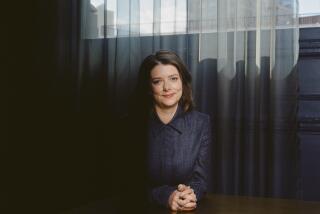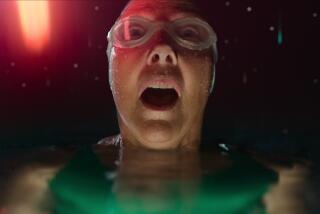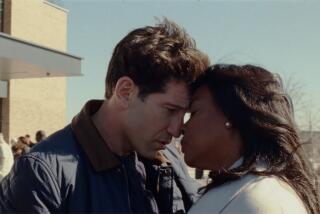Review: Grace shines past the emotional manipulations of ‘The Light Between Oceans’
There’s an early scene in Derek Cianfrance’s “The Light Between Oceans” that precisely captures the movie’s tempestuous emotional undercurrents in miniature. It’s the early 1920s, and Isabel Sherbourne, who has recently suffered a miscarriage, rebukes her husband, Tom, for having sent for a doctor to examine her — an assumption based on a misunderstanding that is soon resolved.
Yet that brief, violent collision of feeling — his quiet calm cushioning her fierce, implacable anger — echoes and reverberates through the picture, meticulously foreshadowing the wrenching human dilemmas that loom on the horizon.
And what a horizon it is. The primary setting of this handsome, halfway-effective prestige weepie — adapted by Cianfrance from M.L. Stedman’s 2012 debut novel — is the fictitious Janus Rock, a small island off the Australian coast. As lusciously photographed in a hundred different golden-pink sunset hues by the cinematographer Adam Arkapaw, the place is an almost unseemly repository of cinematic beauty, alive with the natural poetry — and at times, the inevitable kitsch — of windswept coastal vistas and gold-dappled waves lapping at the shore.
Tom and Isabel are very much of a piece with the movie’s radiance, which is another way of saying that they are played by Michael Fassbender and Alicia Vikander, whose much-publicized off-screen relationship provides this somber movie with both a core of emotional truth and a juicy potential distraction. In this case, at least, truth largely wins out. The actors hurl themselves into their roles with sufficient commitment and feeling that you believe in Tom and Isabel completely, even when the creaky narrative machinery around them begins to trigger your skepticism.
It begins persuasively enough. The horrors of World War I are still fresh when Tom, a gentle, taciturn soul forever haunted by his memories of the Western Front, agrees to take a position as lighthouse keeper on Janus Rock. It’s a job that suits his desire for a life of total isolation — that is, until he falls for Isabel, a spirited young woman from the mainland who renews his sense of joy and purpose. The two soon marry, and their life together on the island is one of blissful simplicity and simple bliss, marred only by a pair of pregnancies that are cut tragically short.
What follows is the story’s most glaring (but not only) contrivance, one that calls forth much agitated camera movement and some churning, Philip Glass-like arpeggios from Alexandre Desplat’s score: A dinghy washes ashore, carrying a man and an infant girl. The man is dead, but the baby lives, and Isabel, her grief abating in the presence of this divine miracle, persuades Tom to leave the discovery unreported in the lighthouse ledgers, so that they can raise the child as their own.
These fateful developments — a startling discovery, a criminal conspiracy hatched in the name of love — serve as a reminder that Cianfrance has a particular affinity for the big, dramatic turning point. His best-known earlier film, “Blue Valentine” (2010), arguably consisted of nothing but turning points as it shuttled back and forth through time, tracing the convulsive arc of a couple’s difficult, doomed relationship.
The director’s underappreciated follow-up, “The Place Beyond the Pines” (2012), adopted a more linear approach that nevertheless still found him pushing against the usual three-act strictures (befitting a student of the legendary avant-garde filmmakers Stan Brakhage and Phil Solomon).
“The Light Between Oceans” is both Cianfrance’s first foray into a non-American period setting and his most traditionally constructed narrative, though he retains his interest in strategically placed flashbacks and shifting perspectives. As the foundling child, Lucy, grows into an adorable girl of 4 (at which point she is played by Florence Clery, a born scene-stealer), another major character emerges in the form of Hannah Potts (a fine Rachel Weisz), a grief-stricken widow who, like the Sherbournes, has her own unique set of war scars. Her mysterious connection to Tom, Isabel and Lucy is easy enough to figure out, even though it will take years — including one nearly three-decade leap into the future — for the characters’ entwined fates to find their proper resolution.
Tom’s function as keeper of the lighthouse flame is both literal and highly symbolic. He is more cursed than blessed by a level of superior knowledge that eludes the others, and in a drama that pivots on its characters’ sudden triumphs and failures of conscience, Tom is the one who will ultimately guide the others to shore, no matter how much it may cost him, or how many fresh tears it may harvest from the audience. How effectively “The Light Between Oceans” earns your own tears — I misted up a little, almost out of a sense of duty — will likely depend on your susceptibility to the story’s manifold manipulations, which are no less transparent for being so skillfully handled.
No movie lover, of course, can rightly claim to hate manipulation; even the purest, most spontaneous emotions are the product of a filmmaker’s successful calculation, and “The Light Between Oceans,” rooted somewhere between the grand tradition of classic melodrama and the seaside tearjerkers of Nicholas Sparks, need not apologize for lingering on Vikander’s flurries of maternal anguish, Weisz’s dignified sniffles and Fassbender’s bravely choked-back sobs.
The deeper problem is that, in its overly insistent visual and musical touches, the film doesn’t amplify so much as thwart the emotional integrity of what it’s showing us.
Although he’s stronger at realizing big moments than finding the connective tissue between those moments, Cianfrance tries to bridge the gaps as gracefully as possible, with an abundance of elegiac voice-over and tenderly observed scenes of a family dwelling together at the very edge of the world. These shots, with their natural lighting and fluttery camerawork, bespeak the subtle influence of the director Terrence Malick — as does the use of John Tavener’s “Funeral Canticle,” a magisterial choral piece that has been in heavy soundtrack rotation since it appeared in Malick’s “The Tree of Life.”
That film pointedly differentiated between the way of nature and the way of grace, between personal gratification and selfless compassion — a human struggle that “The Light Between Oceans” also embodies. Its most powerful moments are predicated less on the characters’ sudden reversals of fortune than on their desperate, flailing attempts to do the right thing under impossible circumstances, and above all to show one another a decency they don’t always deserve. In these fugitive moments, a movie that can seem hard to trust becomes surprisingly easy to forgive.
------------
‘The Light Between Oceans’
MPAA rating: PG-13, for thematic material and some sexual content
Running time: 2 hours, 12 minutes
Playing: In general release
See the most-read stories in Entertainment this hour »
More to Read
Only good movies
Get the Indie Focus newsletter, Mark Olsen's weekly guide to the world of cinema.
You may occasionally receive promotional content from the Los Angeles Times.







